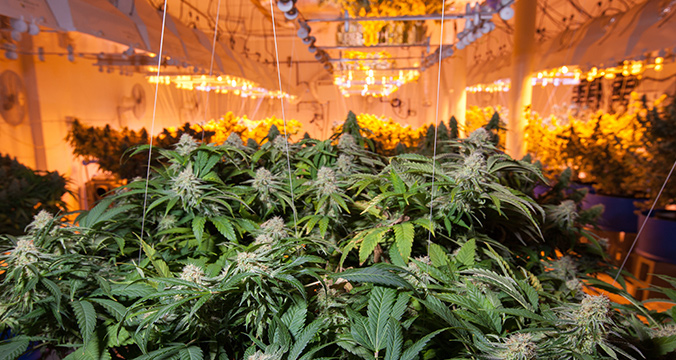6 Steps To Getting Maximum Yields From Autoflowering Strains
Published : Jan 11, 2019

Autoflowering strains offer a simpler approach to growing. Without the need to adjust light cycles to trigger flowering, a considerable amount of complication is removed. The difficulty, however, is maximising yields to get the best return on your time. Keep reading to find out which areas need a slightly different approach to get the best results.
MAKING THE MOST OF AN AUTOFLOWERING STRAIN’S POTENTIAL
Whether this is your first venture into growing cannabis or you are a seasoned cultivator, both categories of grower will have the same goal in mind. You want to get the best possible return (yield) versus the time needed to grow.
Thankfully, because autoflowering strains have fewer plates to spin, there is less complication, and they will nearly always flower. Assuming you know the fundamental aspects needed to grow cannabis, cultivating an autoflowering strain is very similar. However, to get the most out of an auto, a few small tweaks in your routine can go a long way.

IMPROVING YIELD IS THE NAME OF THE GAME
Before we explore what these adjustments are, there is one overriding factor that will affect every cannabis plant, no matter the skill of the grower. We are of course referring to a strain’s genetics. Autoflowering strains are pre-programmed to flower after a specific period, and unlike their photoperiod cousins, this timeframe cannot be manipulated. Therefore, stable genetics go an incredibly long way in ensuring the end result is a favourable one!
The obvious question then becomes: how do I overcome any undesirable attributes produced by strain genetics? The answer to that is simple: by picking a genetically superior strain that has been tried and tested. Luckily, your choices are not limited as the stability of autoflowering strains has come leaps and bounds in recent years. Whether you prefer an indica-dominant strain, a euphoria-inducing sativa, or just want something easy to grow, autoflowering strains can prove more than accommodating.
To give yourself the best possible advantage, spend a small amount of time researching the type of strain you want. Once you have narrowed down your choice, the next step is to find a reputable seller. Double-check the strain’s attributes and see if you can find customer reviews for an unbiased opinion of the seed’s quality. With the building blocks of a successful cannabis project covered, we can now move on to the more specific growing requirements needed to maximise yields.
6 WAYS YOU CAN IMPROVE YIELDS FROM AUTOFLOWERING STRAINS
 1. LIGHT IS STILL A VITAL FACTOR
1. LIGHT IS STILL A VITAL FACTOR
Just because autoflowering strains do not require a change in light cycle to initiate flowering doesn't mean light isn’t important. Both the intensity and duration of the light that you provide your autoflowering plant will have a significant impact on final yield. Given an autoflowering strain is pre-programmed to flower after a set period of time, we need to encourage as much growth as possible within the available window.
To do that, we rely on the natural process of photosynthesi, giving the plant as much light as possible once it has reached the late seedling/early vegetative stage. 20 hours of continuous light with only 4 hours of darkness should maximise growth potential.
 2. AVOID TRANSPLANTING
2. AVOID TRANSPLANTING
Usually, you would transplant a young photoperiod seedling from its germination pod to a larger pot when it enters the vegetative stage. DO NOT do this with an autoflowering strain. Transplanting an autoflowering strain can cause undue stress and put the plant into shock.
Given time is precious, you cannot afford to have the plant spend time trying to recover. You want all its energy to be put into growing. The best strategy with an autoflowering strain is to plant it in a 15–20 litre pot from the get-go. This way, no replanting is needed, and it can see out its entire life cycle in one container.
 3. NUTRIENT CYCLES WILL REQUIRE ADJUSTMENTS
3. NUTRIENT CYCLES WILL REQUIRE ADJUSTMENTS
The exact dosage of nutrients does differ from strain to strain, so consider these recommendations as more of a guideline rather than a rule. Once you have a feel for the level of feeding a particular strain needs, you can tweak as required.
In general, autoflowering strains need less-concentrated nutrient solutions, especially during the seedling phase. Once at least four nodes have appeared, you can begin your nutrient regime at 0.25 its usual strength. With each new node, increase the nutrient solution in 0.25 increments until you are up to full concentration. You cannot improve yields past what the plant is genetically capable of, so force-feeding nutrients will not work. If in doubt, less is usually more with autoflowering strains.
Flushing the plant as it approaches harvest, and adding a bloom stimulator to your nutrient solution, is a handy tip for squeezing the most out of your plant in its final weeks.
 4. SUBSTRATE AND WATERING MATTER
4. SUBSTRATE AND WATERING MATTER
These two elements go hand in hand, so it is worth addressing them at the same time. Ideally, your substrate should be a 50/50 mix to ensure an optimal wet and dry cycle. A combination of coco and perlite is ideal to achieve the right conditions for watering.
Once you are happy with your substrate mix, don’t risk overwatering and damaging plants. We cannot afford to stress these plants in any way, as time is precious. Water your substrate until the liquid begins to stop draining away. This is a sign it has had as much water as it can handle. Now, wait until the substrate is dry before watering again. In most cases, the substrate can take anywhere between 4–6 days to dry depending on conditions.
As your plant develops, the substrate should start drying at a faster rate. Don’t worry that you have done something wrong. Instead, check your plants daily, and stick to only watering when your substrate becomes dry.
 5. PICK YOUR MOMENT TO HARVEST CAREFULLY
5. PICK YOUR MOMENT TO HARVEST CAREFULLY
If you have followed all of the advice above, it would be a crying shame to see your hard work and determination wasted. This is often the case when growers get impatient and decide to harvest a week or two early.
You need to give your plants every opportunity to fully develop their buds. This means leaving them to flower right up until the recommended harvest date provided by the seed bank—or until they pass the trichome test. As long as you have chosen a genetically superior autoflowering strain, you should get the best possible yields by waiting until the last moment to harvest.
 6. INDOOR CULTIVATION IS FAVOURABLE
6. INDOOR CULTIVATION IS FAVOURABLE
That isn’t to say you cannot grow autoflowering strains outdoors, but know that you are at the whim of your local climate. If you live close to the equator, then there is a good chance your plants will get all the sunlight they need. If, however, conditions are less favourable, indoor growing is the preferred option. Don’t forget, you are in a race against the clock, so any downtime in light coverage or intensity will impact that bountiful haul.
As you can see, only a few fundamental principles need changing to achieve the best results. With these changes, your autoflowering plants will be bursting with potent buds in no time.






































